Discover 20 hidden attractions, cool sights, and unusual things to do in Belmont (United States). Don't miss out on these must-see attractions: Smithsonian Astrophysical Observatory, Boston Massachusetts Temple, and Edwin Abbot House. Also, be sure to include Schlesinger Library in your itinerary.
Below, you can find the list of the most amazing places you should visit in Belmont (Massachusetts).
Table of Contents
Smithsonian Astrophysical Observatory
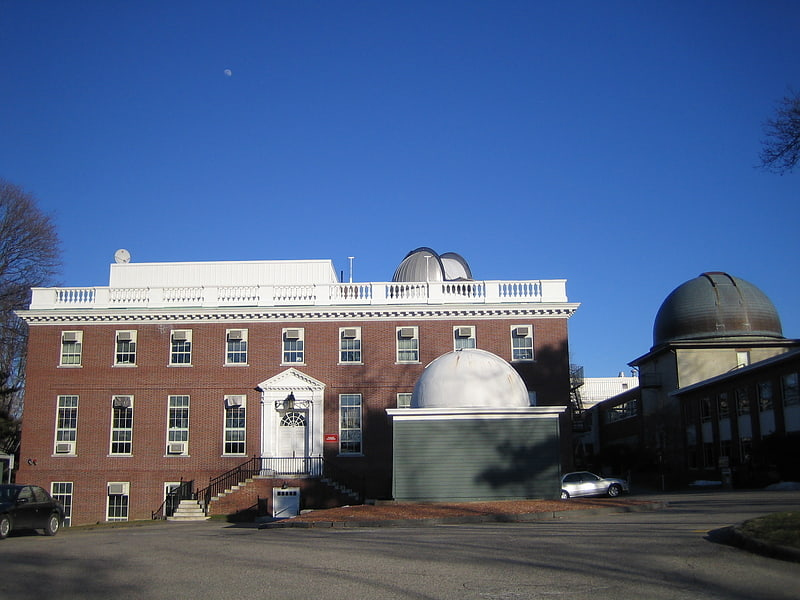
The Smithsonian Astrophysical Observatory is a research institute of the Smithsonian Institution, concentrating on astrophysical studies including galactic and extragalactic astronomy, cosmology, solar, earth and planetary sciences, theory and instrumentation, using observations at wavelengths from the highest energy gamma rays to the radio, along with gravitational waves. Established in Washington, D.C., in 1890, the SAO moved its headquarters in 1955 to Cambridge, Massachusetts, where its research is a collaboration with the Harvard College Observatory and the Harvard University Department of Astronomy. In 1973, the Smithsonian and Harvard formalized the collaboration as the Center for Astrophysics | Harvard & Smithsonian under a single Director.[1]
Boston Massachusetts Temple
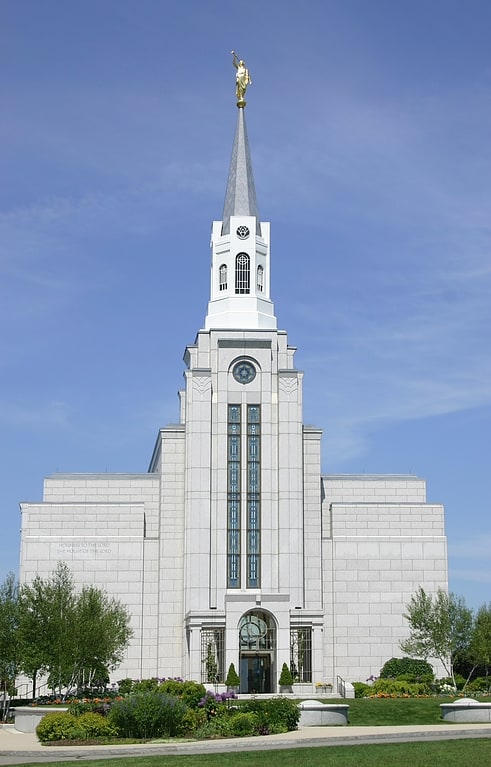
Temple in Belmont, Massachusetts. The Boston Massachusetts Temple is the 100th operating temple of The Church of Jesus Christ of Latter-day Saints.[2]
Address: Frontage Rd., 02478 Belmont (Belmont)
Edwin Abbot House

The Edwin Abbot House, also known as the Zabriskie House, is an historic house at 27 Garden Street in Cambridge, Massachusetts. Built in 1889 to a design by Longfellow, Alden & Harlow, it is a prominent local example of residential Richardsonian Romanesque architecture. It has served as the principal building of the Longy School since 1937. It was listed on the National Register of Historic Places in 1979, and included in the Follen Street Historic District in 1986.[3]
Schlesinger Library
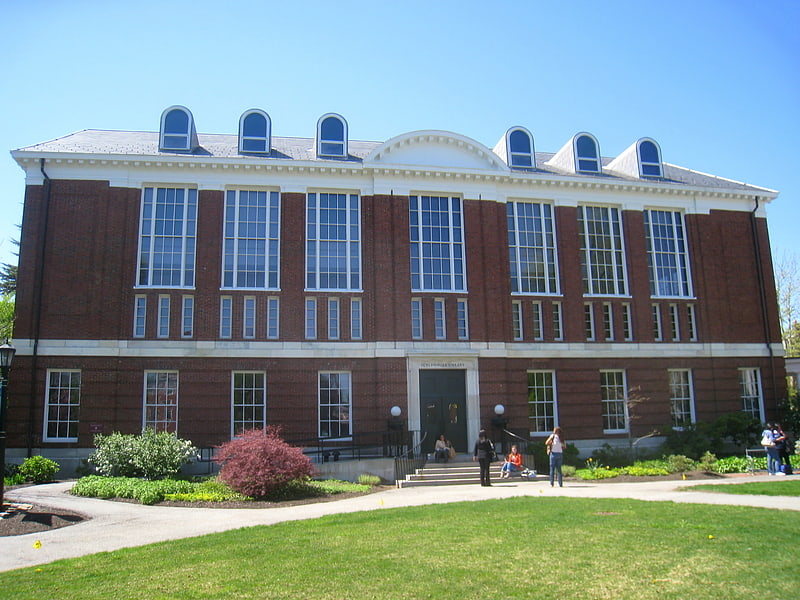
Library in Cambridge, Massachusetts. The Arthur and Elizabeth Schlesinger Library on the History of Women in America is a research library at the Radcliffe Institute for Advanced Study, Harvard University. According to Nancy F. Cott, the Carl and Lily Pforzheimer Foundation Director, it is "the largest and most significant repository of documents covering women's lives and activities in the United States".[4]
Address: 3 James Street, Belmont (Cambridge)
West Cambridge

Neighborhood in Cambridge, Massachusetts. West Cambridge, also known as "Area 10", is a neighborhood in Cambridge, Massachusetts. It is bounded by the Charles River on the south, JFK Street on the east, Concord Avenue on the north, and Fresh Pond, Aberdeen Avenue, and the Watertown line on the west.
In 2005 it had a population of 8,266 residents living in 3,887 households, and the average household income was $80,746.
The racial demographics in 2000 were 86.5% White, 5.9% Asian/Pacific Islander, 4.1% Black, 3.7% Hispanic origin, 0.1% Native American, 1.0% other race.[5]
The Montrose
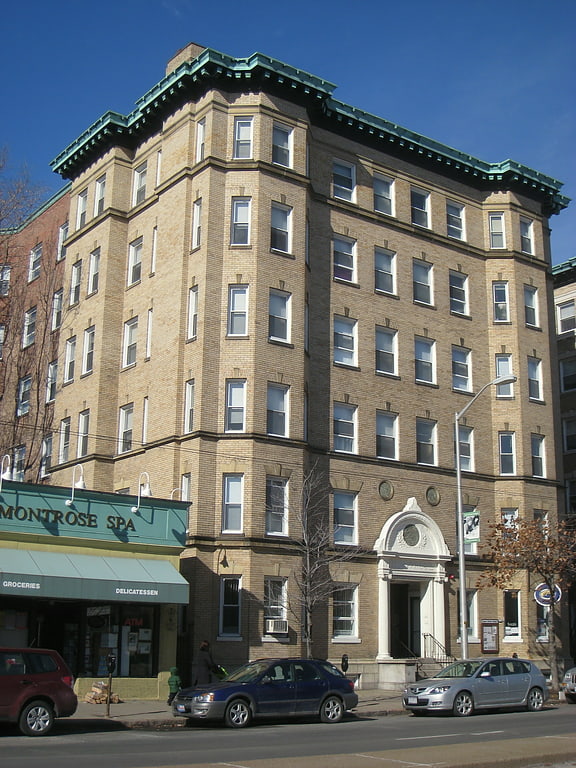
Building in Cambridge, Massachusetts. The Montrose is a historic multiunit residential building in Cambridge, Massachusetts. It is a six-story yellow brick building, whose Italian Renaissance details include a copper cornice with modillions, varied window treatments on each floor, belt courses of brickwork between some of the floors, and a front entry surround with fluted Doric columns. Built in 1898, it was one of the first "French flat" luxury apartment houses built in the city. The building was listed on the National Register of Historic Places in 1986.
According to a promotional booklet published in 1899, it was constructed 25 feet from its adjoining apartment block, The Dunvegan, with which it connects via an underground passage. Both buildings are of the same height and similar size (six stories in height, with a frontage of eighty-five feet), built of the same materials, and with a similar architectural appearance, although the Montrose's floorplan is roughly rectangular but the Dunvegan's is triangular. The Montrose's vestibules, front hall, and stairway are finished in Siena marble, mahogany, and mosaic floors. Each of its twelve suites originally consisted of ten rooms and a bath, as follows: parlor, reception-room, library, dining-room, four bed rooms, kitchen and servant's room, bath room, servant's water-closet, and butler's pantry.
When constructed, the building was wired for door bells and electric lights, and piped for gas and hot and cold running water. Heating was provided by low-pressure steam.[6]
Address: 1646 Massachusetts Avenue, Belmont (Cambridge)
Clay Pit Pond

Pond in Massachusetts. Clay Pit Pond, also known as Claypit Pond, is a pond in the Boston suburb of Belmont in Middlesex County, Massachusetts situated between Concord Avenue and Belmont High School. It is a man-made pond, excavated as the source of clay for industrial brick-making on the site from 1888 to 1926. The pond was formed in 1933 when the Wellington Brook was redirected to flood the site, making it an essential part of the drainage system for much of Belmont.
The Parry Brothers first opened a brickyard in the vicinity of the current pond in 1888. In 1900, nearly all brick making operations in Middlesex County were merged into the New England Brick Company, which acquired the site and increased production to 15 million bricks per year with a work force of 75. By 1926, the highest quality clay was exhausted and the site was abandoned, reportedly leaving behind an 1884 Marion steam shovel at the bottom of the pit.
The pond is inhabited by bluegill, common carp, and largemouth bass, among other species.
The Town of Belmont purchased the abandoned pit in 1927 for $22,500 to use as a waste dump site. However, in 1933, the Town diverted the Wellington Brook through a culvert to flood the site with 80 million gallons of water, creating the Clay Pit Pond.
In March 2010, the pond overflowed onto the road after two days of rain, closing down the adjacent high school.
In September 2020, several Belmont citizens illegally removed more than 80 trees and shrubs from the south side of Clay Pit Pond. The unauthorized deforestation of this protected wetland area has raised environmental concerns.[7]
Conventual Church of St. Mary and St. John

Church in Cambridge, Massachusetts. The Conventual Church of St. Mary and St. John is a historic Episcopal church in Cambridge, Massachusetts. The Romanesque Revival church was built in 1936 to a design by architect Ralph Adams Cram. Cram sought to reproduce 12th century ecclesiastical forms found in the Burgundy region of France. The building was featured in a 1941 architectural magazine. It is home to monks of the Society of Saint John the Evangelist of the Episcopal Church.
The church was listed on the National Register of Historic Places in 1982.[8]
Fresh Pond Parkway
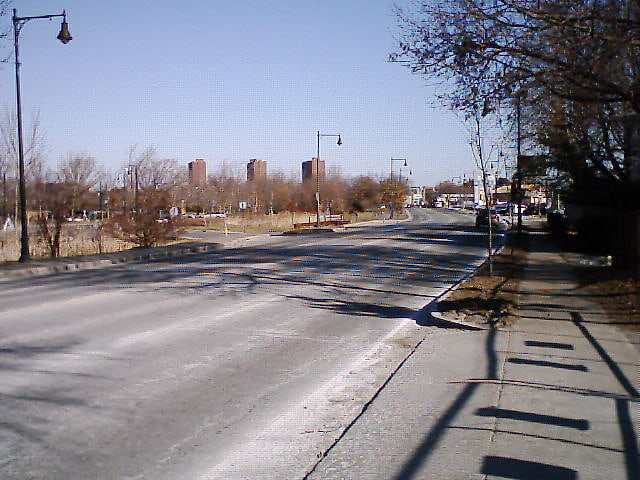
Road in Cambridge, Massachusetts. Fresh Pond Parkway is an historic park and parkway, found in the westernmost neighborhoods of Cambridge, Massachusetts. The parkway was built in 1899 and added to the National Register of Historic Places in 2005.
Fresh Pond Parkway is a four-lane road (two lanes in each direction) stretching from Mount Auburn Street on its southern end to a rotary at Concord Avenue (formerly Cambridge and Concord Turnpike) and Alewife Brook Parkway to the north. Much of the parkway acts as eastern boundary for portions of the city's municipal Fresh Pond reservoir area and also serves to connect the reservoir to the Charles River Reservation.
The parkway is part of Massachusetts Route 2 (Route 2) and U.S. Route 3 (US 3) for its entire length. The portion north of Huron Avenue is also part of Route 16.[9]
Asa Gray House
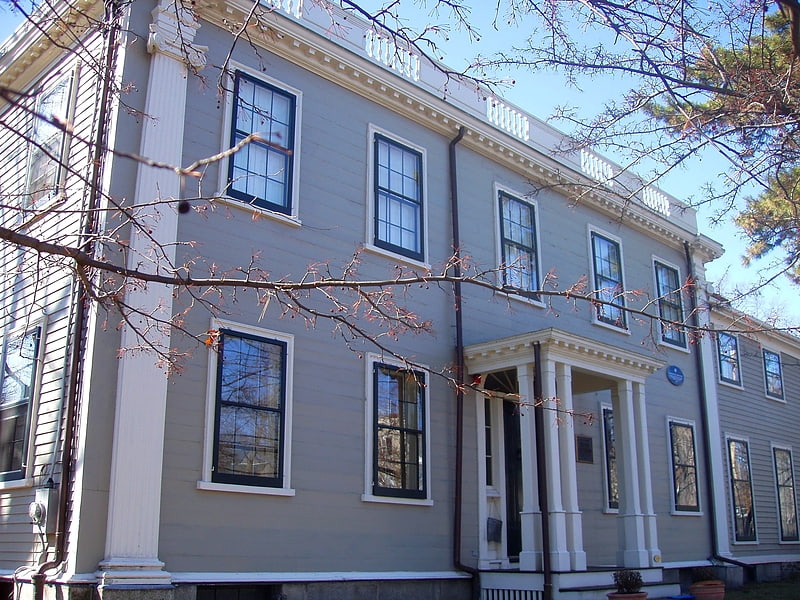
The Asa Gray House, recorded in an HABS survey as the Garden House, is a historic house at 88 Garden Street, Cambridge, Massachusetts. A National Historic Landmark, it is notable architecturally as the earliest known work of the designer and architect Ithiel Town, and historically as the residence of several Harvard College luminaries. Its most notable occupant was Asa Gray, a leading botanist who published the first complete work on American flora, and was a vigorous defender of the Darwinian theory of evolution.[10]
Address: 88 Garden Street, Belmont (Cambridge)
Cambridge Home for the Aged and Infirm
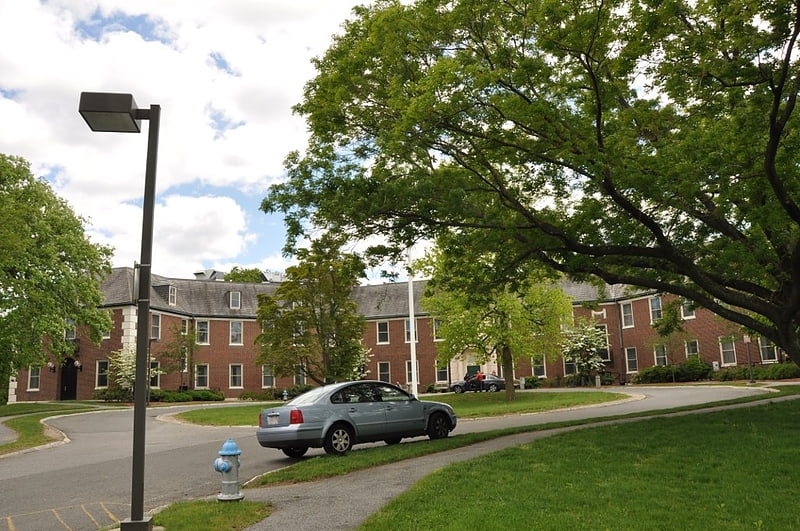
Building in Cambridge, Massachusetts. The Cambridge Home for the Aged and Infirm is an historic building on 650 Concord Avenue in Cambridge, Massachusetts. Built in 1928 by the city, it is one of the oldest surviving municipal facilities for the housing of elderly and incurably ill patients, rather than indigents. It is now operated as Neville Place, an assisted living community managed by Senior Living Residences. The building was built in 1928 by Charles Reggio Greco and added to the National Register of Historic Places in 2002.[11]
Reginald A. Daly House

The Reginald A. Daly House is a historic house located in Cambridge, Massachusetts. It is a National Historic Landmark, notable for its association with Reginald Aldworth Daly, an eminent geologist, Penrose Medal winner, and Harvard University professor.
The house is a two-story wood-frame structure, estimated to have been built in the 1880s or 1890s. The house is styled in a Queen Anne/Shingle style, but is not particularly architecturally distinguished. Its interior had (as of its designation in 1976) not been significantly altered since Daly's death. Reginald Daly was born in Ontario, and was educated at Victoria College (now the University of Toronto). He then engaged in graduate studies at Harvard, earning an MA. and PhD in geology. In 1908 Daly began teaching at the Massachusetts Institute of Technology, and in 1912 he joined the faculty of Harvard, where he remained for the rest of his life. He purchased this house in 1910. Daly's contributions to the field of geology were wide-ranging: he was one of the first to synthesize a consistent theory of igneous rocks, based on an extensive analysis of a large body of physical evidence. He was also instrumental in bringing physics and chemistry into the study of geology. He was widely recognized by his peers, and received numerous honors, including the first honorary degree granted by his alma mater, Victoria College.
The house was designated a National Historic Landmark in 1976, and was listed on the National Register of Historic Places. It was further included in the Old Cambridge Historic District in 1983.[12]
Mass Audubon Habitat

Garden, Nature and wildlife, Park, Relax in park
Address: 10 Juniper Rd, 02478-2034 Belmont (Belmont)
Theodore W. Richards House
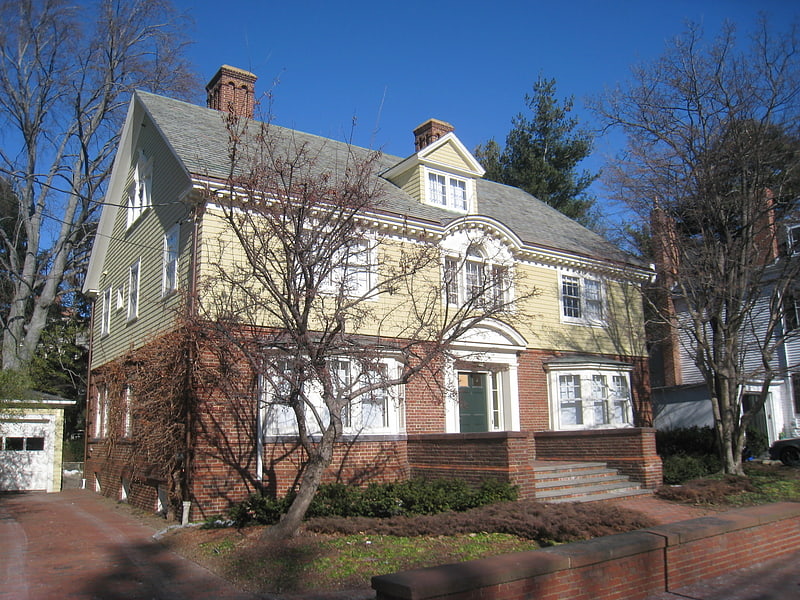
The Theodore W. Richards House is a National Historic Landmark at 15 Follen Street in Cambridge, Massachusetts. Built in 1900, it was the home until his death of Theodore William Richards, the first American to be awarded the Nobel Prize in Chemistry. Richards was a leading experimental chemist of his day, measuring the atomic weights of a large number of elements. He was also responsible for the growth of Harvard University's graduate chemistry program to one of the finest in the nation. The house was designated a National Historic Landmark in 1976.[13]
Lowell School
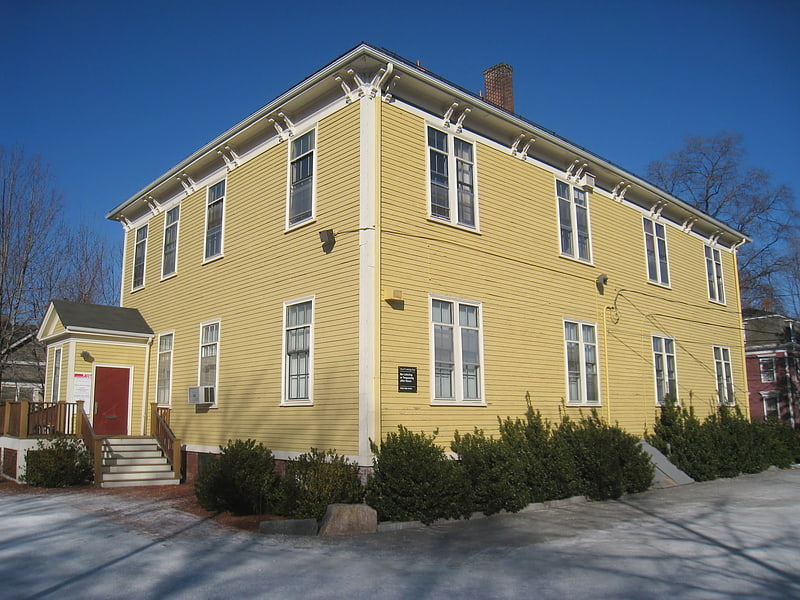
Building in Cambridge, Massachusetts. The Lowell School is an historic school building at 25 Lowell Street in Cambridge, Massachusetts. Built in 1883, it is the only surviving wood-frame school building in the city. It is a two-story structure, with a hip roof, clapboard siding, and a brick foundation. The building has minimal decoration, with Italianate brackets in the eaves, and paired narrow windows in the Italianate style. It was designed by local architect James Fogerty assisted by his son, George Fogerty, who both designed many public, commercial, and residential buildings in the city.
The building was listed on the National Register of Historic Places in 1982.[14]
Second Waterhouse House
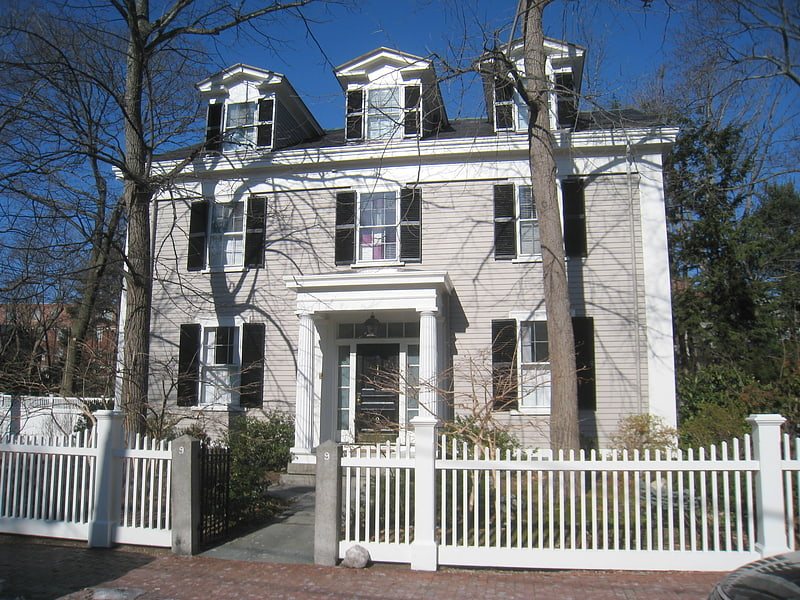
The Second Waterhouse House is an historic house at 9 Follen Street in Cambridge, Massachusetts. The 2+1⁄2-story wood-frame house was built on 1844, and is the most quintessentially Greek Revival house in the Follen Street Historic District. It was built by Benjamin Waterhouse, and is one of the earliest houses built on the street. Of particular historical interest is the assortment of heating systems that have been installed in the house since 1853, remnants of some of which are still found in the house's basement.
The house was listed on the National Register of Historic Places in 1983.[15]
Sears Tower – Harvard Observatory
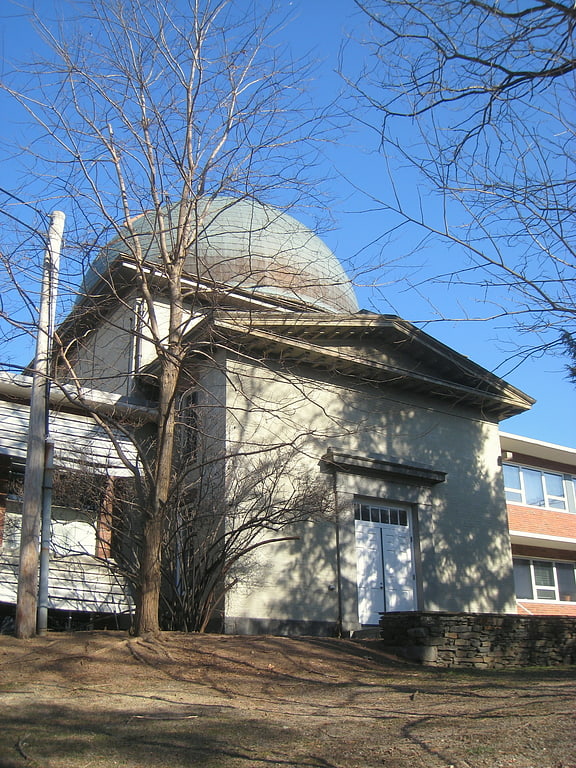
The Sears Tower—Harvard Observatory is a historic astronomical observatory that is part of Harvard Observatory and is located at 60 Garden Street in Cambridge, Massachusetts. Now just a portion of the observatory's Building A, the Sears Tower is the oldest portion of the complex, designed by Isaiah Rogers and constructed in 1843. This structure is a square brick building, with a projecting cornice and a Greek Revival entrance framed by pilasters. The dome was equipped with a 15-inch telescope, the state of the art at the time.
The tower was listed on the National Register of Historic Places in 1987.[16]
Joseph Holmes House
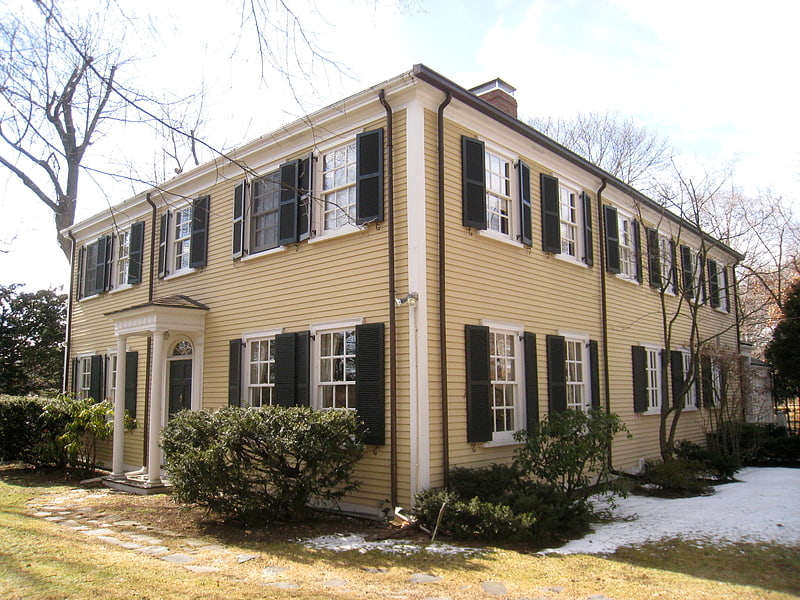
The Joseph Holmes House is an historic house at 144 Coolidge Hill Street in Cambridge, Massachusetts. The 2+1⁄2-story wood-frame house was built in 1801 by John Holmes, father of Joseph Holmes. It was originally located on Appian Way in Harvard Square, and was moved to its present location in 1929, at which time an ell was also added. It is a well-preserved yet unpretentious Federal-style house, a rarity in "Old Cambridge", where such houses were once quite common. This house is not particularly pretentious, with a five-bay facade and center entrance, and is set sideways on its narrow lot.
The house was listed on the National Register of Historic Places in 1983.[17]
Edward Dodge House
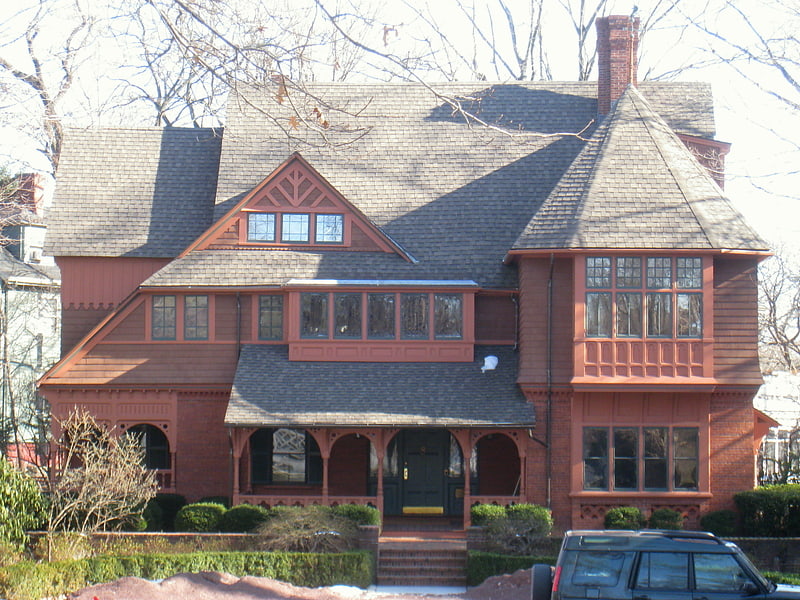
The Edward Dodge House is a historic house at 70 Sparks Street in Cambridge, Massachusetts. The 2+1⁄2-story wood-frame house was built in 1878 to a design by Longfellow and Clark. It has asymmetrical massing typical of Queen Anne styling, and also has a style of half-timbering on its upper levels that was popular in England in the 1860s. The exterior surfaces have a variety of textures, create by different sheathing types, including vertical boards, wood paneling, and brick patternwork.
The house was listed on the National Register of Historic Places in 1982.[18]
Address: 70 Sparks Street, Belmont (Cambridge)
Percy W. Bridgman House

The Percy W. Bridgman House is an historic house at 10 Buckingham Place in Cambridge, Massachusetts, United States. It is a National Historic Landmark, notable for its associations with Dr. Percy Williams Bridgman, a physicist, Nobel Prize winner, and Harvard University professor. It is now part of the Buckingham Browne & Nichols Lower School campus.
The house is an architecturally undistinguished 21⁄2 story house built about 1920 in a Neo-Rationalist style. At the time of its designation as a National Historic Landmark in 1975, the house had not been significantly altered since Dr. Bridgman's death in 1961. It was acquired by the BBN School not long after his death, which has used it for a variety of purposes, including as a faculty residence and lounge. It is used for school offices.
Percy Bridgman (1882–1961) was born in Cambridge, raised in Newton, and educated at Harvard. After receiving his Ph.D. in physics in 1908, he was invited to join the Harvard physics faculty, where he remained for the rest of his life. Bridgman's primary area of research was high pressure physics. He was awarded the Nobel Prize in Physics (the fifth American to be so honored) in 1946 for his development of equipment for advancing research in that field. He also wrote extensively on the epistemology of physics and the sciences, advancing an idea that became known as operationalism, the view that the concept underlying any measurement was synonymous with a corresponding set of operations performed in making the measurement. Bridgman moved into this house in 1928, and lived there for the rest of his life.[19]
Address: 10 Buckingham Place, Belmont (Cambridge)